As an Amazon Associate KitchenwareSets.com earns from qualifying purchases.
7 Easy DIY Kitchen Island Projects to Build Your Dream Space
Is your kitchen the one room in the house where you’re constantly fighting for more space? Juggling cutting boards on a sliver of counter, stacking pots and pans in a precarious tower, and wishing you had a central spot for meal prep or a casual breakfast is a daily struggle for many. It’s a frustration that can make the heart of your home feel more like a cramped corridor than a welcoming hub for creativity and connection.
This constant battle for elbow room can make cooking feel like a chore. You dream of a kitchen that flows, a space with enough surface area to spread out ingredients, an extra spot for the kids to do their homework, or a casual place for friends to gather with a glass of wine while you cook. The high cost of a full-scale remodel or a pre-made kitchen island can make that dream feel completely out of reach, leaving you stuck in your current, inefficient layout.
The solution is closer and more affordable than you think: a DIY kitchen island is a standalone counter unit you build yourself to add workspace, storage, and seating to a kitchen. It’s a cost-effective alternative to pre-made islands, offering complete customization over size, features (like seating or storage), and style to perfectly match your space. Updated for 2025. As a passionate DIYer who has transformed multiple kitchens on a budget, I’ve learned that a well-planned island is the single most impactful project you can undertake.
Lacking Counter Space? Discover How a DIY Island Can Transform Your Kitchen
A DIY kitchen island is the ultimate solution for adding functional counter space, custom storage, and stylish appeal to a cramped kitchen without the expense of a major renovation. By building your own, you gain complete control over the size, layout, and features, ensuring it perfectly fits your needs and enhances your kitchen’s workflow. It’s a project that is surprisingly achievable for various skill levels and delivers a massive return in both utility and aesthetics.
The frustration of a kitchen with inadequate workspace is universal. It’s the dance of shuffling items around just to find a spot for your mixing bowl, the lack of storage that leads to cluttered countertops, and the absence of a central gathering point that can make a kitchen feel disconnected. A DIY island directly tackles these pain points. It instantly introduces a generous new surface for everything from chopping vegetables to rolling out dough. It can be designed with deep drawers for pots, open shelving for cookbooks, or cabinets for small appliances, immediately decluttering your existing counters. More than just a workspace, it becomes the magnetic heart of the room—a place for morning coffee, after-school snacks, and easy conversations.
7 Easy DIY Kitchen Island Projects You Can Start This Weekend
The best way to start your DIY kitchen island journey is by choosing a project that matches your skill level and budget, from assembling basic stock cabinets to creatively upcycling an old piece of furniture. These seven projects offer a range of styles and complexities, each designed to be a clear, step-by-step guide to help you build the perfect island for your dream space. We’ve curated these 7 projects based on their popularity, ease of execution for beginners, and the high-quality results they produce, drawing from countless real-world DIY successes.
Whether you’re looking for a classic, built-in look or a flexible, mobile cart, there’s a plan here for you. We’ll walk through everything from the foundational base cabinet method to clever IKEA tipss and charming farmhouse designs. Each idea is broken down with a complete materials list and actionable directions, ensuring you have the confidence to get started.
1. The Classic: Building an Island from Stock Cabinets
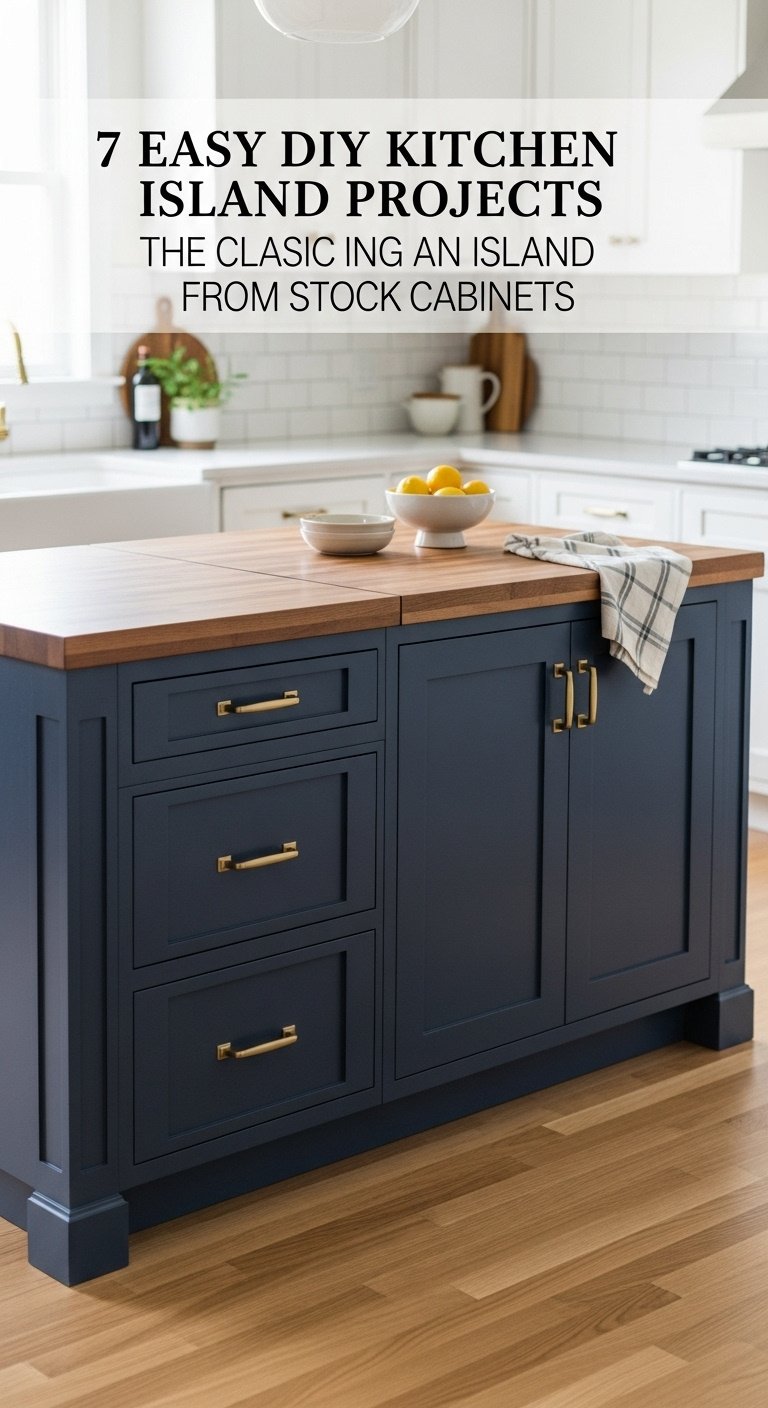
Save this foundational island plan to your ‘Dream Kitchen’ board!
This method is the go-to for a reason: it’s straightforward, sturdy, and yields a professional-looking result that seems custom-built. By using ready-to-assemble (RTA) or stock base cabinets from a home improvement store, you’re starting with a solid foundation that takes the guesswork out of building the core structure.
- Materials Needed: 2-3 stock base cabinets, 2×4 lumber for base cleats, wood screws (3-inch and 1.25-inch), wood glue, shims, decorative paneling (beadboard, plywood), countertop material, L-brackets, paint or stain, wood filler, cabinet hardware.
- Step-by-Step Directions:
- Plan Your Layout: Arrange cabinets to your desired size. Place two back-to-back for a deeper island. Measure the final footprint.
- Build & Secure the Base: Create a floor frame with 2x4s to match the cabinet footprint. Level it with shims and screw it securely into the floor joists.
- Assemble the Island: Clamp the cabinets together and connect them with 1.25-inch screws through the inside of the cabinet frames.
- Attach to Base: Lift the assembled cabinets onto the 2×4 base and screw down through the cabinet floor into the cleats.
- Add Finishing Panels: Cut decorative panels to size to cover the back and sides. Attach with wood glue and small finishing nails.
- Install the Countertop: Center the countertop, allowing for your desired overhang. Secure it from below by screwing L-brackets to the cabinet frame and the underside of the top.
- Finish: Fill nail holes, caulk seams, and paint or stain the base. Install hardware.
Pro-Tip: When screwing cabinets together, place screws near the top and bottom of the stiles (the vertical frame pieces) where the wood is thickest to ensure a tight, secure connection without splitting the wood.
2. The IKEA Hack: A Stylish & Affordable Island
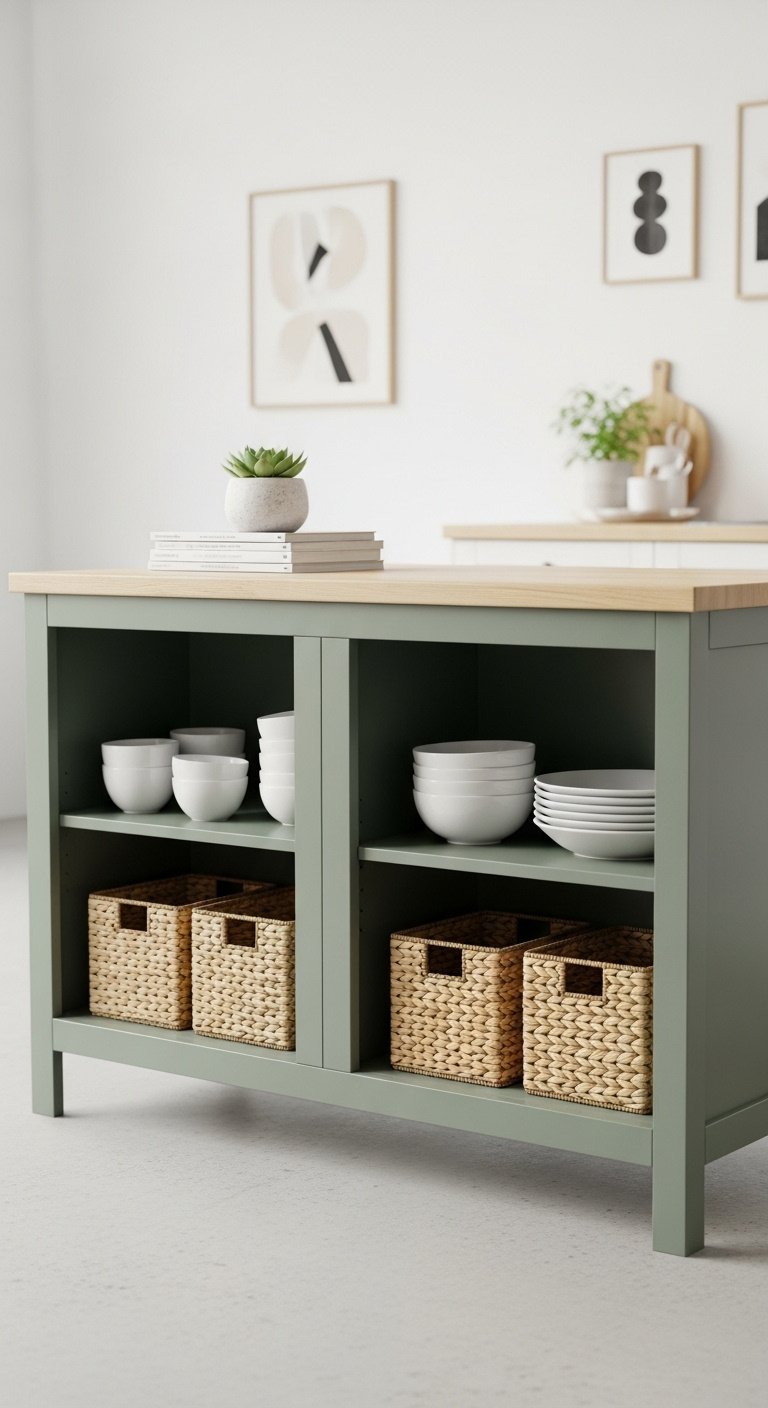
Pin this clever IKEA tips for your next budget-friendly project!
For a modern, budget-friendly, and stylish solution, nothing beats a good IKEA tips. Using versatile and modular furniture like the KALLAX shelving units provides a simple starting point for a custom island that offers fantastic open storage.
- Materials Needed: 2 IKEA KALLAX or similar shelving units, adhesion-promoting primer, cabinet paint, countertop material, construction adhesive, optional heavy-duty casters.
- Step-by-Step Directions:
- Assemble Units: Build both IKEA units according to the manufacturer’s instructions.
- Prime and Paint: Lightly sand all surfaces. Apply one coat of adhesion-promoting primer, let it dry completely, then apply 2-3 coats of your chosen cabinet paint.
- Join the Units: Place the units back-to-back and clamp them together. Use screws or connecting bolts to secure them to each other for stability.
- Attach Countertop: Apply a generous amount of construction adhesive to the top edges of the joined units. Carefully place your countertop, ensuring it’s centered. Weigh it down with heavy objects while the adhesive cures.
- (Optional) Add Wheels: For a mobile island, attach heavy-duty locking casters to the bottom four corners before joining the units.
Lesson Learned: Don’t skip the adhesion-promoting primer! IKEA furniture has a slick laminate finish, and regular paint will easily scratch or peel off without proper preparation.
3. The Rustic Farmhouse Island with Shiplap
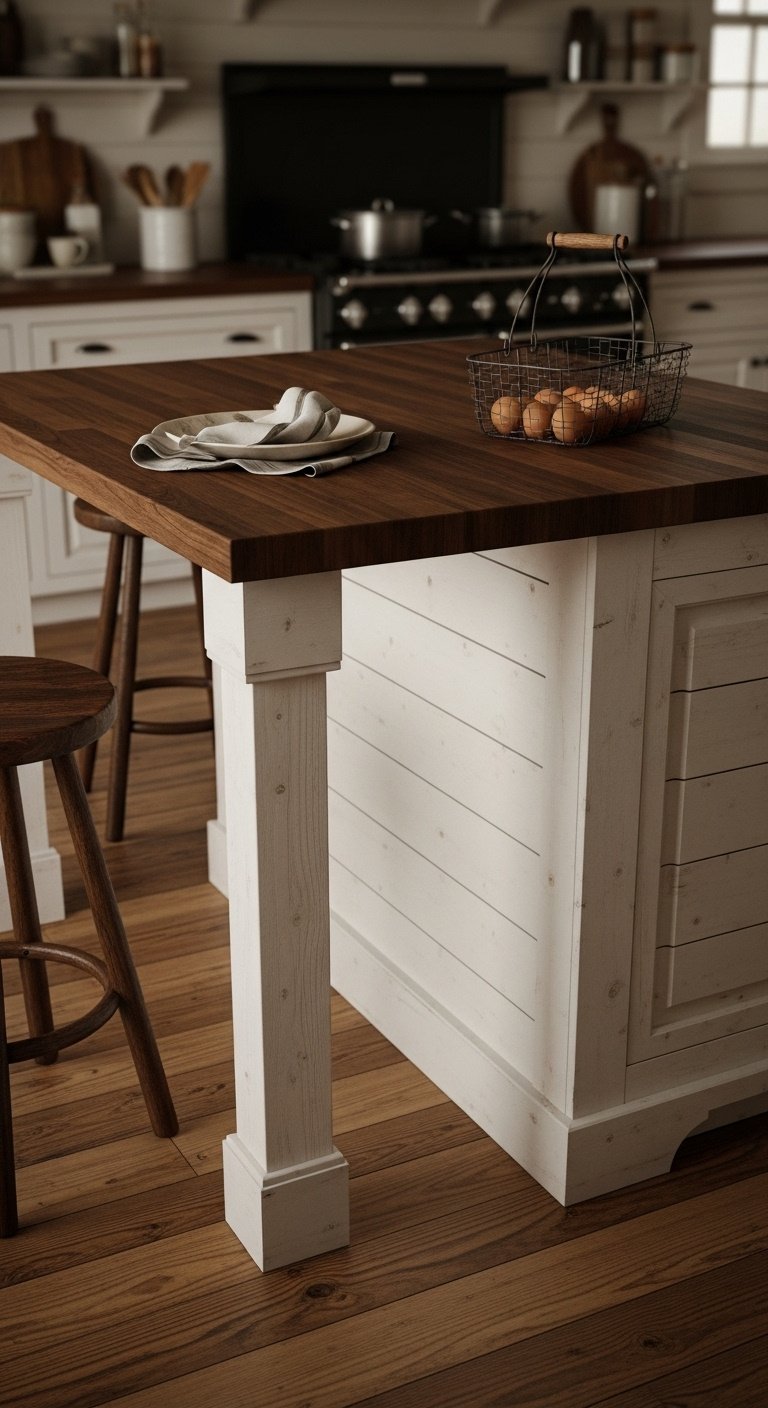
Get the farmhouse look! Save this shiplap island idea to your ‘Home Goals’ board.
Capture that cozy, inviting farmhouse aesthetic by building a custom-framed island and cladding it in classic shiplap. This project allows for complete customization of size and can easily incorporate an overhang for casual seating.
- Materials Needed: 2×4 lumber for frame, plywood for sides, shiplap boards, brad nailer, wood glue, dark wood stain, white paint (chalk or milk paint), sandpaper, butcher block countertop, L-brackets.
- Step-by-Step Directions:
- Build the Frame: Construct a rectangular box frame from 2x4s to your desired dimensions. Add vertical supports every 16-24 inches for rigidity.
- Sheath the Frame: Cover the sides and back of the frame with plywood sheets, screwing them into the 2x4s.
- Apply Shiplap: Starting from the bottom, attach shiplap boards horizontally around the plywood exterior using a brad nailer and wood glue.
- Finish the Base: Paint the shiplap base. For a distressed look, lightly sand the edges after the paint has dried.
- Stain and Seal Countertop: Apply your desired stain to the butcher block, wiping away excess. Once dry, apply several coats of food-safe sealer or polyurethane.
- Attach Top: Secure the finished countertop to the base frame using L-brackets from underneath. Ensure you have a 12-15 inch overhang on the seating side.
Pro-Tip: To get perfect, consistent gaps between your shiplap boards, use a nickel or a spacer tool as you nail each board in place. This small trick makes a huge difference in the final professional look.
4. The Mobile Kitchen Cart on Wheels
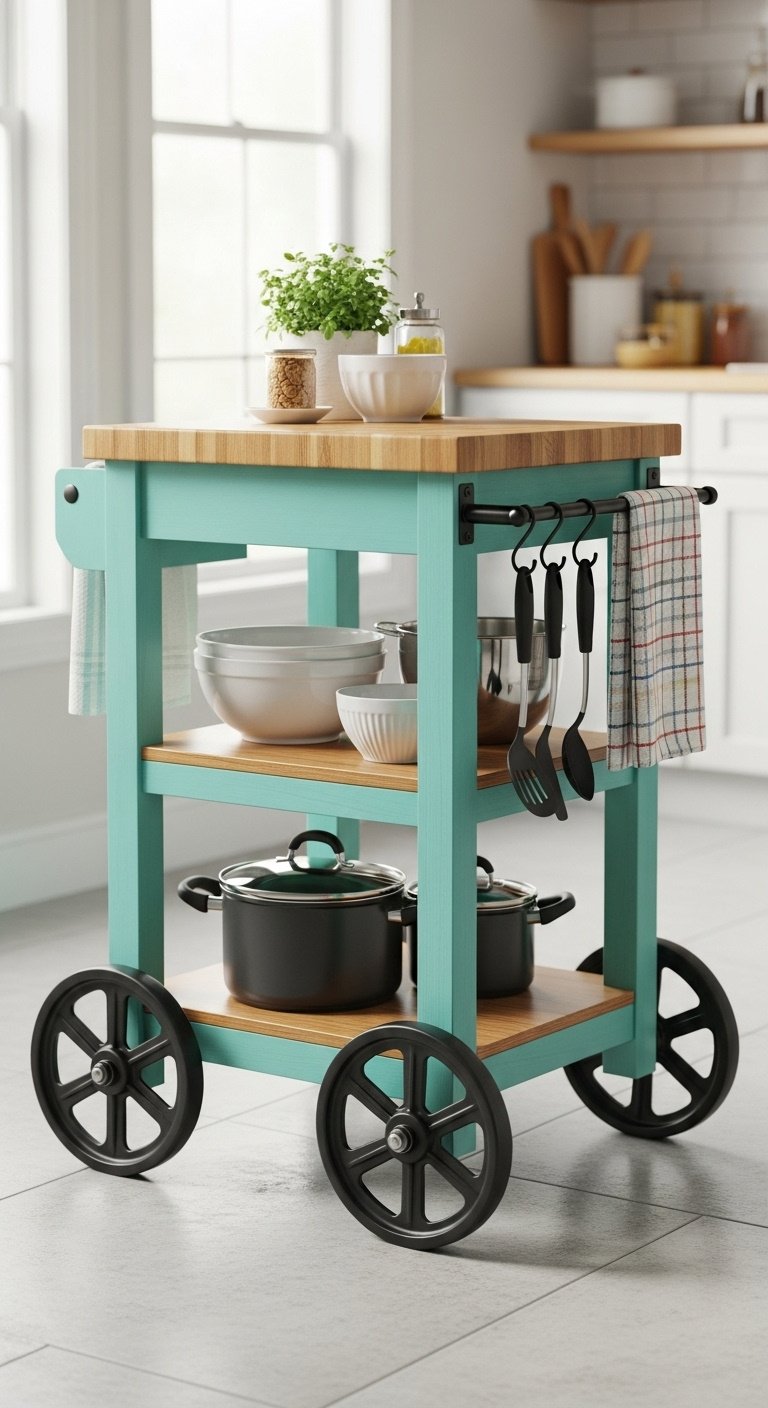
Need flexibility? Pin this mobile island idea for a kitchen that adapts to you!
Perfect for small kitchens or for those who love to rearrange their space, a mobile kitchen cart offers flexibility that a stationary island can’t. You can roll it where you need it for prep work and push it aside to create more room when entertaining.
- Materials Needed: 4×4 lumber for legs, 2×4 lumber for frame and shelf supports, 1×6 boards for shelves, butcher block for top, heavy-duty locking casters, wood screws, wood glue, paint or stain, optional towel bar.
- Step-by-Step Directions:
- Cut Legs: Cut four 4×4 posts to your desired height, minus the height of your casters.
- Build Shelf Frames: Create two identical rectangular frames from 2x4s to connect the legs. These will support your shelves.
- Assemble the Cart: Attach the legs to the inside corners of the shelf frames using wood glue and screws. One frame should be near the bottom, and one in the middle or higher, depending on your design.
- Install Casters: Securely screw the locking casters to the bottom of each 4×4 leg.
- Add Shelves & Top: Cut your 1×6 boards to size and lay them across the shelf supports to create the shelving. Attach the butcher block top to the top of the legs with screws from underneath.
- Finish: Sand everything smooth, then paint or stain. Add a towel bar to the side for extra functionality.
Lesson Learned: Invest in quality, heavy-duty casters with reliable locks. A cart loaded with kitchen items is heavy, and cheap wheels can buckle or fail to lock, creating a safety hazard.
5. The Upcycled Dresser: A Character-Filled Island
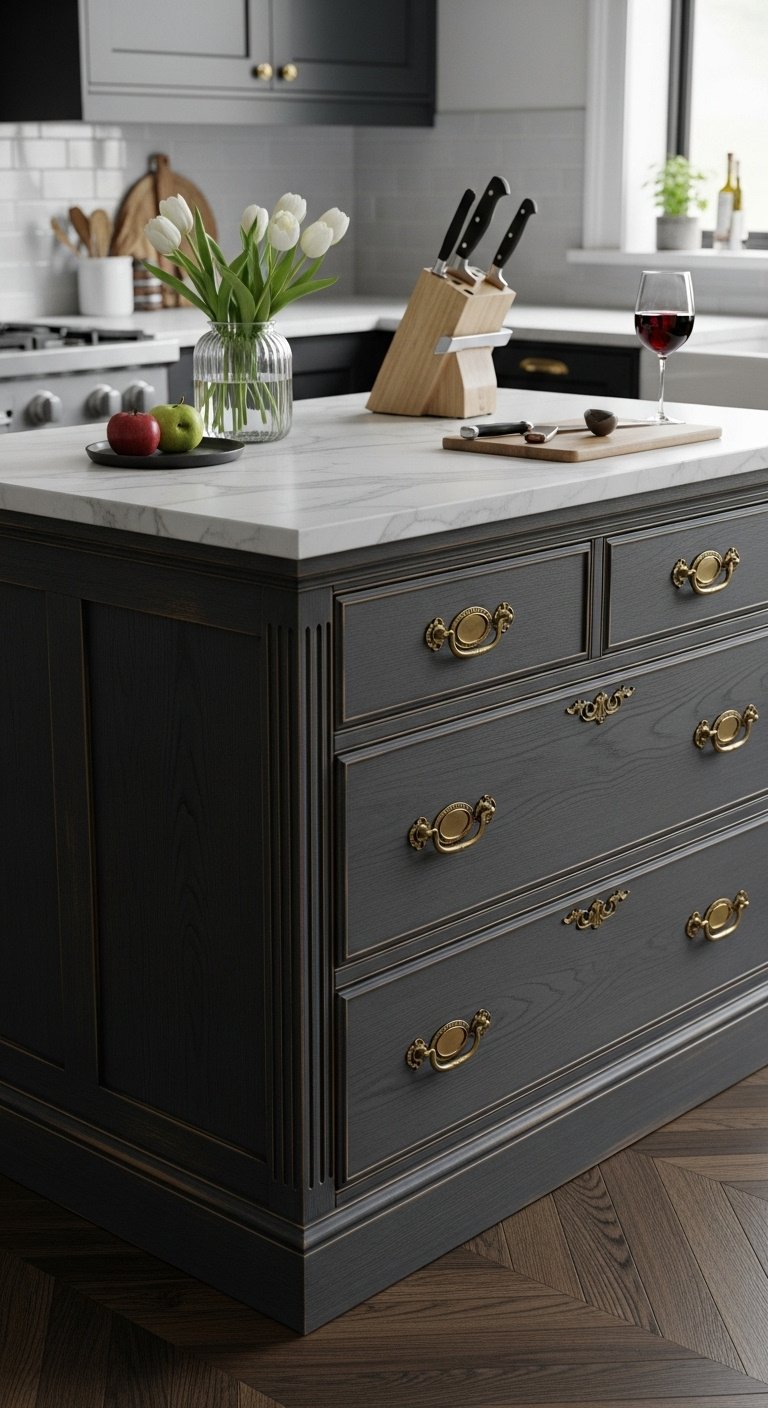
Love a good upcycle? Save this dresser island transformation for your next thrifty find!
Give a new life to an old piece of furniture by transforming a sturdy vintage dresser into a one-of-a-kind kitchen island. This approach is sustainable, budget-friendly, and infuses your kitchen with unique character and instant storage.
- Materials Needed: A sturdy, solid wood dresser, sandpaper, cleaner/degreaser, paint (chalk paint is great for this), new countertop material, construction adhesive, optional wood blocks for height/reinforcement.
- Step-by-Step Directions:
- Source Your Piece: Find a solid wood dresser at a thrift store or marketplace. Ensure it’s the right height (or can be modified) for a comfortable workspace (typically 36 inches).
- Prep the Dresser: Remove all hardware. Thoroughly clean the entire piece with a degreaser. Lightly sand all surfaces to give the paint something to grip.
- Paint and Finish: Apply 2-3 coats of your chosen paint, allowing for proper drying time between coats. Apply a durable topcoat like polyurethane for protection.
- Reinforce the Top: Add wood blocks to the inside top corners of the dresser frame to provide a larger surface area for the new countertop to rest on and adhere to.
- Attach the New Top: Apply construction adhesive to the top of the dresser and any reinforcement blocks. Carefully center and place your new countertop. Weigh it down to cure.
- Reinstall Hardware: Clean the original hardware or install new knobs and pulls.
Pro-Tip: Before committing to a dresser, measure your kitchen clearance. A common mistake is falling in love with a piece that’s too deep, leaving you with less than the recommended 36-42 inches of walkway around it.
6. The Minimalist: A Sleek Open-Shelf Island
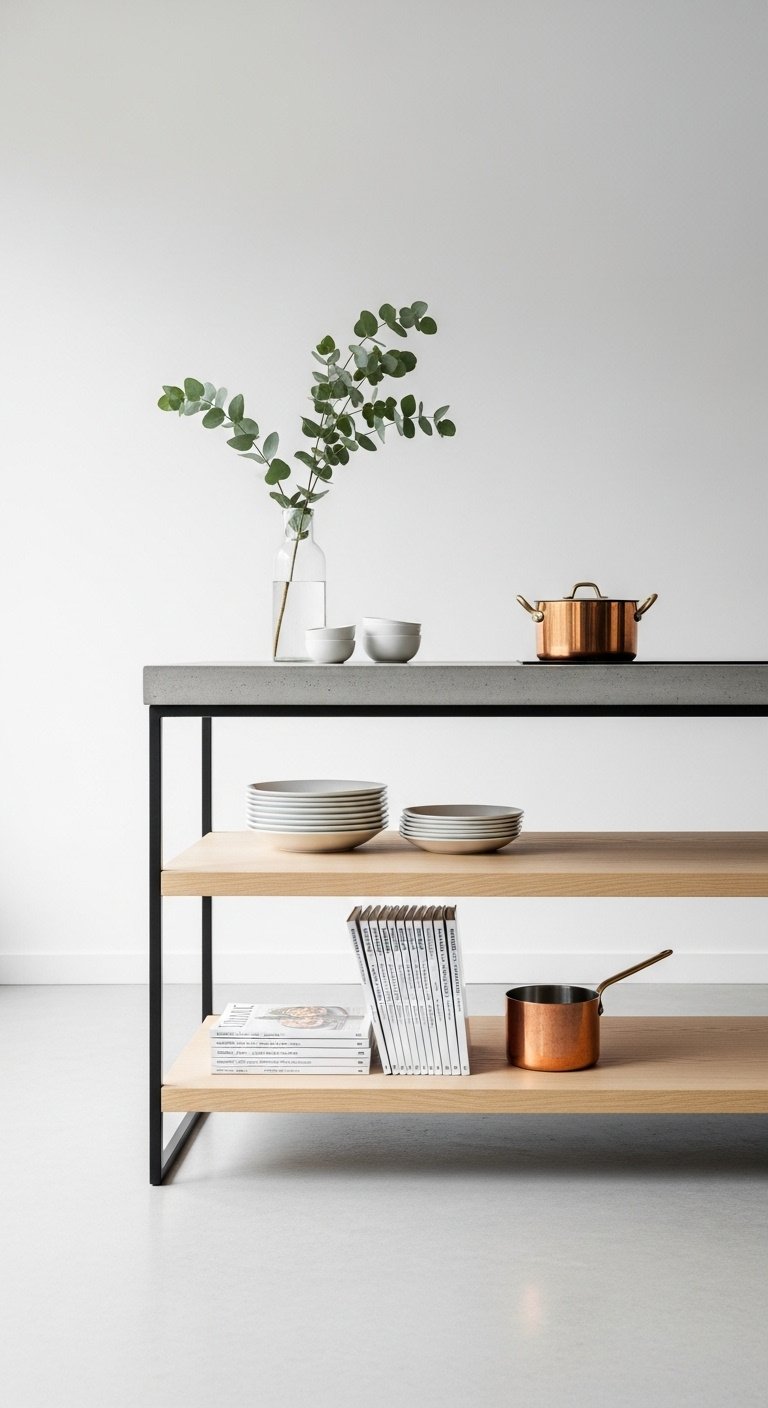
Craving a clean look? Pin this minimalist open-shelf island design.
For an airy, modern aesthetic, an open-shelf island is a perfect choice. It provides valuable surface area and accessible storage without the visual weight of solid cabinets, making your kitchen feel larger and more open.
- Materials Needed: 4×4 lumber for legs (or metal piping for an industrial look), 2x4s for shelf supports, thick wood planks (like 2x10s) for shelves, countertop material, screws, wood finish (like tung oil or polyurethane).
- Step-by-Step Directions:
- Construct the Legs: Create four legs of equal height (around 35 inches).
- Build the Frame: Build two rectangular frames using 2x4s to support the shelves, similar to the mobile cart project. Attach these frames to the legs at your desired shelf heights.
- Cut & Finish Shelves: Cut your thick wood planks to length to serve as the shelves. Sand them smooth and apply a protective finish.
- Assemble: Secure the finished shelves onto the support frames.
- Add the Top: Attach your countertop material directly to the top of the four legs. For a simple look, a thick, high-quality piece of butcher block can serve as both the structure and the surface.
Lesson Learned: The key to a beautiful open-shelf island is curation. Since everything is on display, plan to use matching dishes, neat stacks of books, or stylish baskets to keep it looking organized and intentional, not cluttered.
7. The Entertainer: A Bar-Style Island with Seating
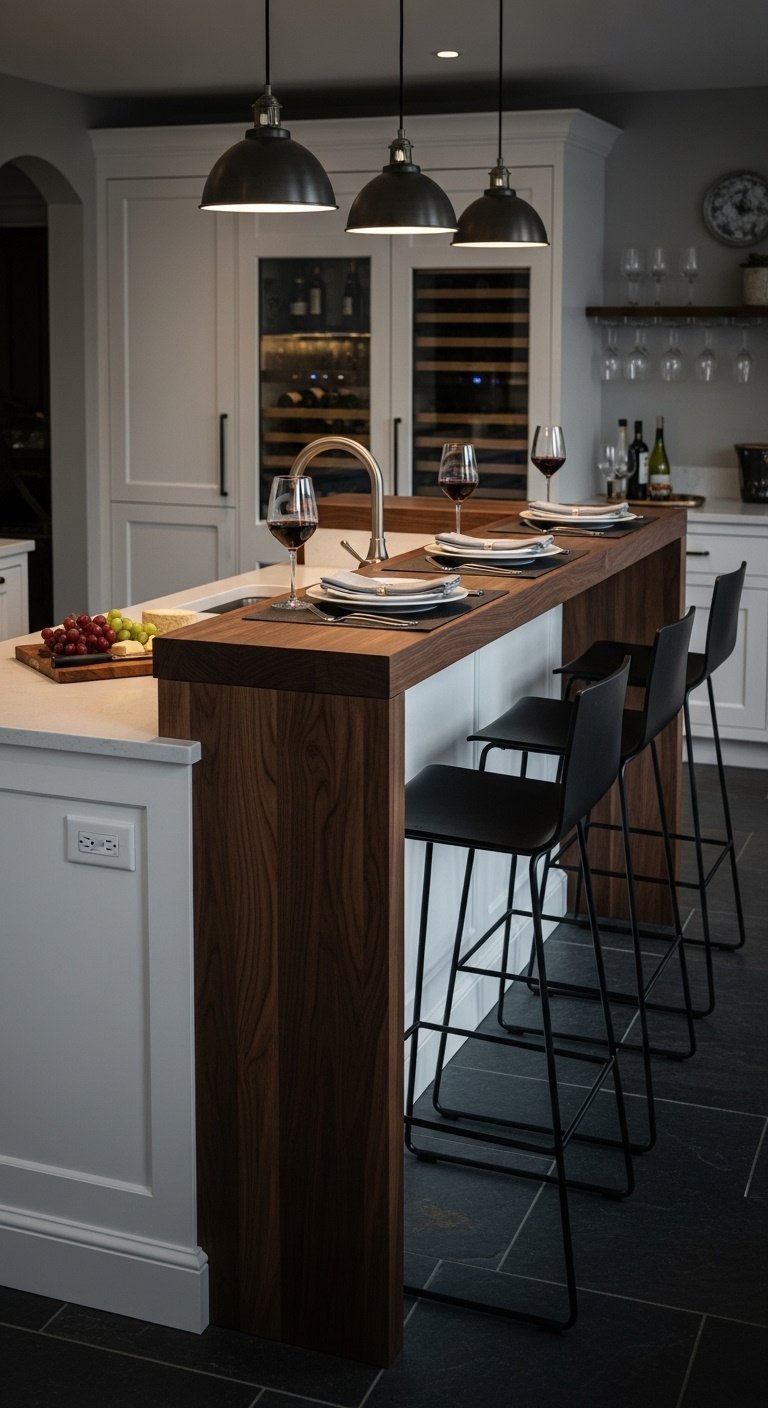
Love to host? Save this entertainer’s island plan to your ‘Dream Home’ board!
If your kitchen is the social hub of your home, design an island specifically for entertaining. By creating a generous countertop overhang, you can easily add bar stools for a breakfast bar or a comfortable spot for guests to chat while you cook.
- Materials Needed: Stock base cabinets, 2x4s for a half-wall or “pony wall” frame, countertop material, decorative paneling, heavy-duty countertop support brackets or corbels, wood screws, wood glue.
- Step-by-Step Directions:
- Assemble the Base: Secure your base cabinets in a row as you would for a standard island.
- Build the Seating Wall: Behind the cabinets, build a short 2×4 wall (a pony wall) that is the same length as your cabinet run. This wall will support the back of the countertop and create the overhang. Securely anchor this wall to the floor.
- Connect Structures: Screw the back of the cabinets into the pony wall to create one solid unit.
- Add Finishing Panels: Cover the exposed back and sides of the pony wall with drywall or decorative paneling (like beadboard) to match the island base.
- Install Supports: Attach large, decorative corbels or hidden steel support brackets to the pony wall every 20-24 inches to support the countertop overhang.
- Install Countertop: Secure the countertop to both the cabinets and the support brackets, ensuring a 12-15 inch overhang for comfortable seating.
- Finish: Caulk, paint, and add trim to give the island a seamless, built-in look.
Pro-Tip: Don’t underestimate the need for robust support. A granite or quartz overhang is incredibly heavy. Use large, structural corbels or hidden steel brackets rated for the weight of your countertop to prevent dangerous sagging or cracking.
Key Takeaways: Your Quick Guide to a DIY Kitchen Island
- Plan First, Build Second: Always measure your kitchen and ensure at least 36-42 inches of clearance around the island before buying materials.
- Base Cabinets are Your Best Friend: The easiest and most popular method for a sturdy, professional-looking island is to join stock base cabinets.
- Seating Needs Space: For comfortable seating, plan for a countertop overhang of at least 12-15 inches and provide heavy-duty support with corbels or brackets.
- Don’t Skip the Finish Work: Cladding exposed backs with panels like beadboard or shiplap, and adding trim and hardware, is what makes a DIY project look custom-built.
- Upcycling is Smart & Stylish: Repurposing furniture like an old dresser can give you a unique, character-filled island for a fraction of the cost.
People Also Ask About DIY Kitchen Islands
Is it cheaper to buy or build a kitchen island?
It is almost always significantly cheaper to build your own kitchen island. A pre-made island can cost thousands, while a DIY version using stock cabinets or repurposed materials can often be completed for a few hundred dollars. Building it yourself saves on labor costs and allows you to choose budget-friendly materials.
What is the 3×4 kitchen rule?
The “3×4 kitchen rule” is a design guideline to ensure good workflow and safety. It suggests having at least three feet of clearance for walkways between countertops and at least four feet of space between major work zones, like the sink and the stove, to allow for comfortable movement and multiple people working.
Can I DIY a kitchen island?
Absolutely. DIY-ing a kitchen island is one of the most accessible and rewarding home improvement projects, even for beginners. By starting with simple plans, like those using stock base cabinets or IKEA furniture, you can create a functional and beautiful island with basic tools and careful planning, adding immense value to your kitchen.
Final Thoughts
Building your dream kitchen doesn’t have to come with a nightmare price tag. With a little planning and creativity, you can craft a beautiful, functional DIY kitchen island that becomes the true heart of your home. You’ll not only save money but also gain the immense satisfaction of knowing you built it yourself.
Which island project are you most excited to try? Let us know in the comments below
